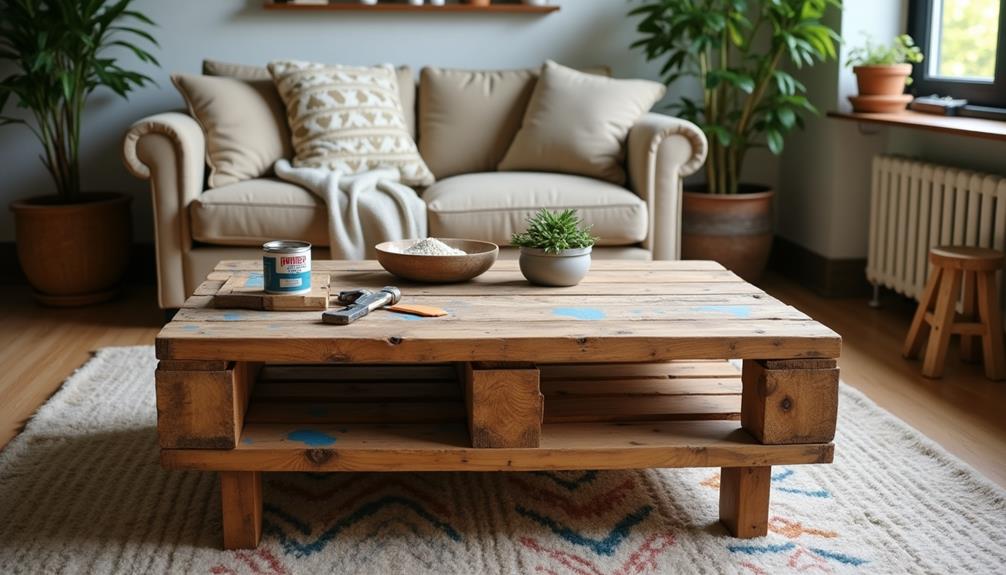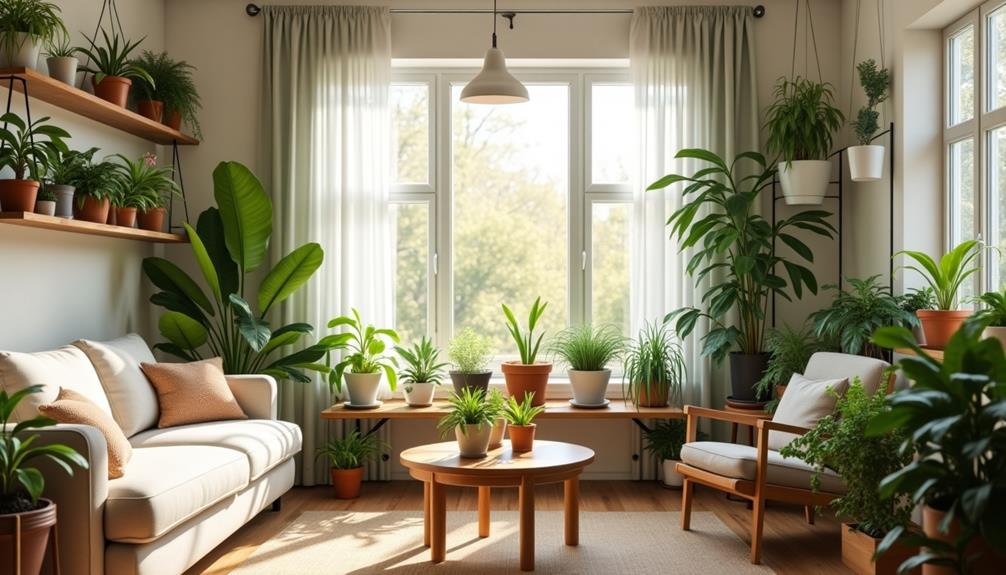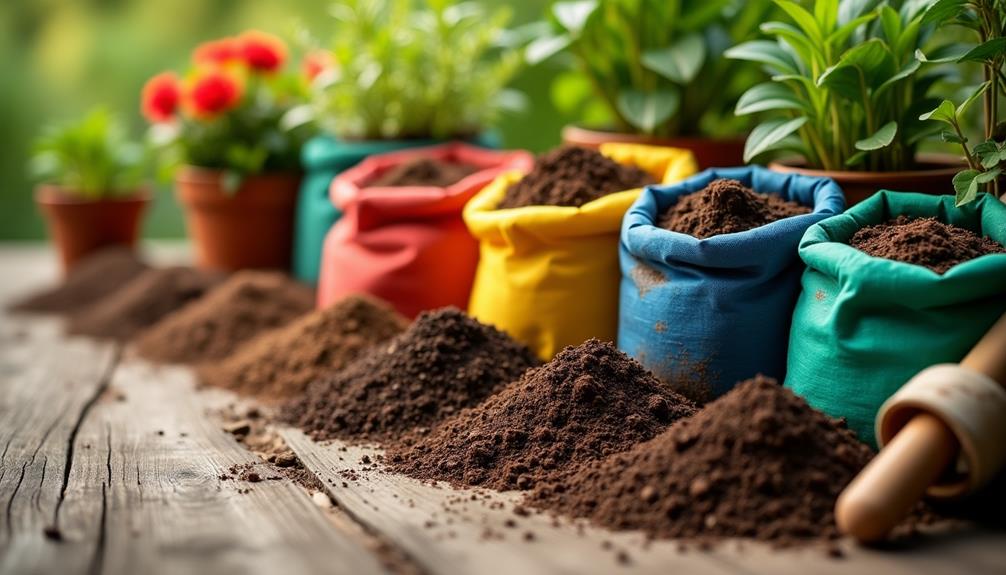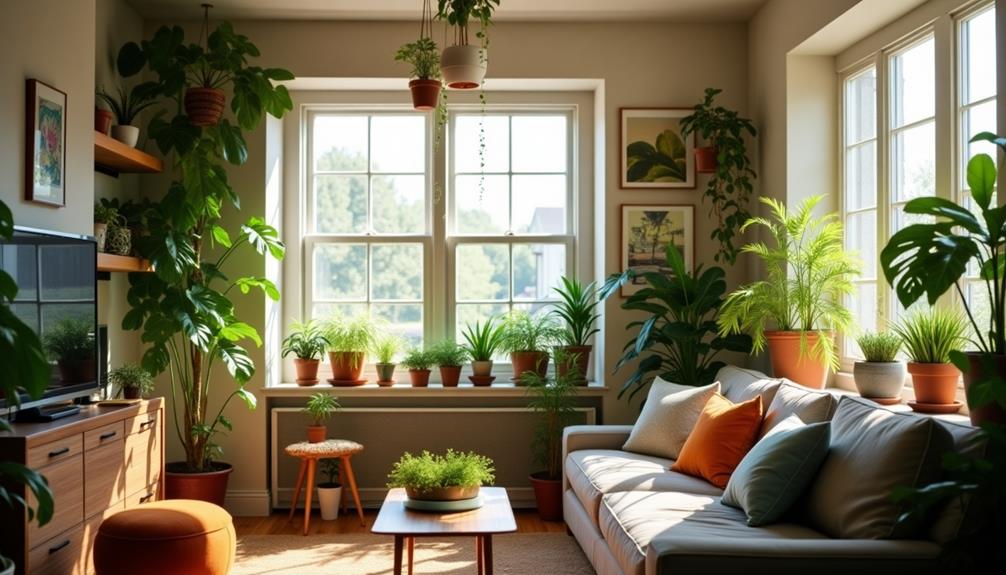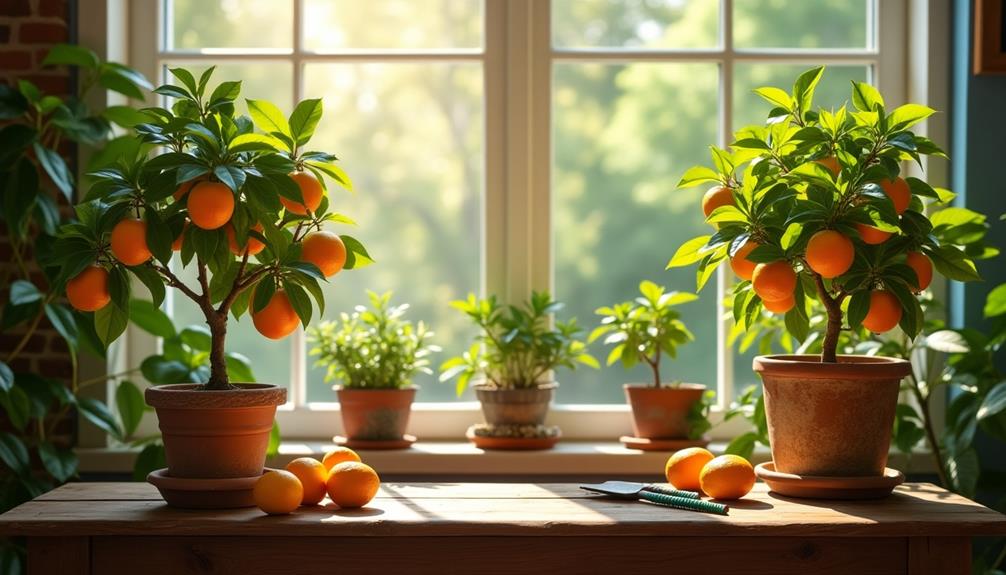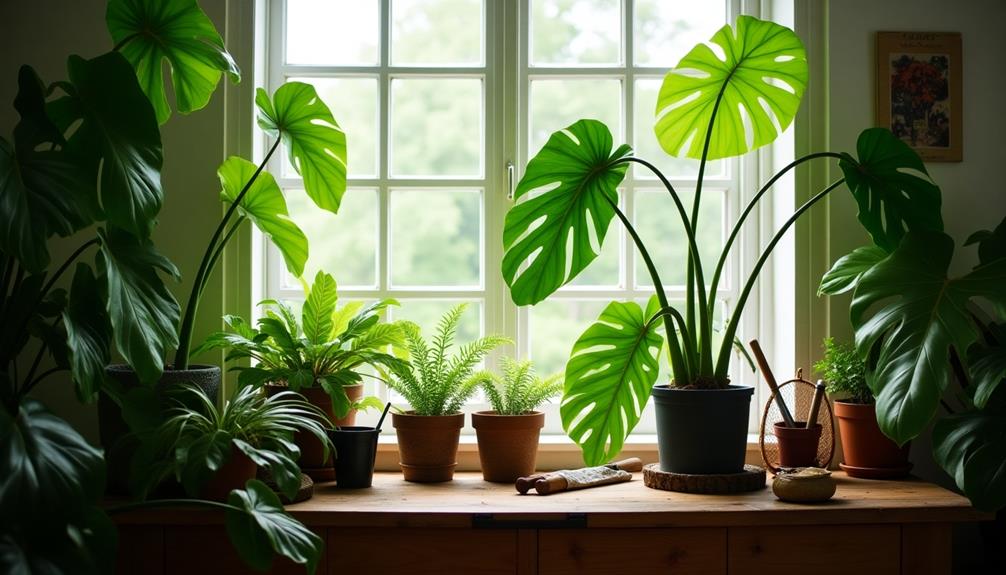When you decide to make a pallet coffee table, you're not just creating furniture; you're also embracing a sustainable and cost-effective approach to home decor. Start by choosing the right pallets, as quality matters significantly in the final product. Once you've gathered your tools and materials, you'll find that preparation is key to a successful build. However, it's the design choices that can truly elevate your table from ordinary to extraordinary. What options will you consider to personalize your creation? Let's explore the steps that lead to a stunning centerpiece for your living space.
Choosing the Right Pallets

When choosing the right pallets for your coffee table, how do you know which ones will work best? First, consider the pallet types available. You'll find that standard wooden pallets are common, but there are also heat-treated pallets, which are safer if you're concerned about pests.
Look for pallets made from high-quality wood, as they'll provide better durability and aesthetics.
Next, think about where you'll be sourcing these pallets. Local businesses often have surplus pallets they're willing to part with, and you might even find some at warehouses or construction sites.
Always check for signs of damage, such as cracks or broken boards, as these can compromise your project.
Once you've selected your pallets, inspect them for cleanliness. You want to avoid any pallets that have been treated with harmful chemicals or have visible stains.
You wouldn't want those contaminants in your living space. By carefully considering pallet types and sourcing, you'll ensure your coffee table project isn't only stylish but also safe and sustainable.
Happy crafting!
Tools and Materials Needed
To build your pallet coffee table, you'll need a few essential tools and materials to ensure the process goes smoothly.
Start with a selection of pallets; different pallet types can offer unique aesthetics and durability. Look for sturdy, untreated pallets that complement your design inspiration.
You'll need a saw, preferably a circular saw, to cut the pallets to your desired size. A drill and screws are essential for assembling the table, along with sandpaper or a power sander to smooth out rough edges.
A measuring tape will help you ensure everything fits together perfectly, while a level will confirm your table stands evenly.
Don't forget safety gear like gloves and goggles. If you want to finish your table, consider wood stain or paint to enhance its look.
Finally, gather a paintbrush or cloth for application.
With these tools and materials at hand, you'll be well-equipped to create a stylish and functional pallet coffee table that reflects your personal design inspiration.
Happy building!
Preparing the Pallets

Preparing the pallets is a crucial step in creating your coffee table. Start by choosing the right pallets, as this will set the foundation for your project. Use pallet selection tips like checking for durability, looking for heat-treated pallets rather than chemically treated ones, and ensuring there are no visible signs of damage or rot. This ensures you're working with sturdy materials.
Once you've selected your pallets, it's time to follow the pallet preparation steps. Begin by cleaning them thoroughly to remove dirt, dust, and any residues. You can use a power washer or scrub them down with soap and water. After cleaning, let them dry completely to prevent mildew.
Next, inspect each pallet for any protruding nails or sharp edges and remove them. Sand the surfaces to smooth out any rough patches, making it safe for use and giving it a polished look.
If desired, you can also apply wood treatment or sealant at this stage to enhance durability. Completing these preparation steps will set you up for a successful coffee table project that not only looks good but is also functional and safe.
Designing Your Coffee Table
Creativity plays a vital role in designing your coffee table, as it allows you to tailor the piece to fit your personal style and home decor. Start by considering different coffee table styles that resonate with you. If you love rustic decor, think about incorporating natural wood finishes and textures.
For those drawn to modern aesthetics, sleek lines and minimalistic designs might be your best bet. Functional design is crucial, so keep space considerations in mind. Ensure that your table complements your seating arrangement and provides adequate surface area without overcrowding the room.
Color coordination is another key element; choose hues that harmonize with your existing palette. Explore DIY techniques and upcycling ideas to create a unique piece that reflects your personality. You might paint your table in a seasonal theme, adding a fresh vibe throughout the year.
Don't forget to add personal touches, like decorative items or a centerpiece, to make the table your own. Ultimately, your coffee table shouldn't only serve its purpose but also enhance the beauty of your living space, making it a true representation of your style.
Assembling the Table
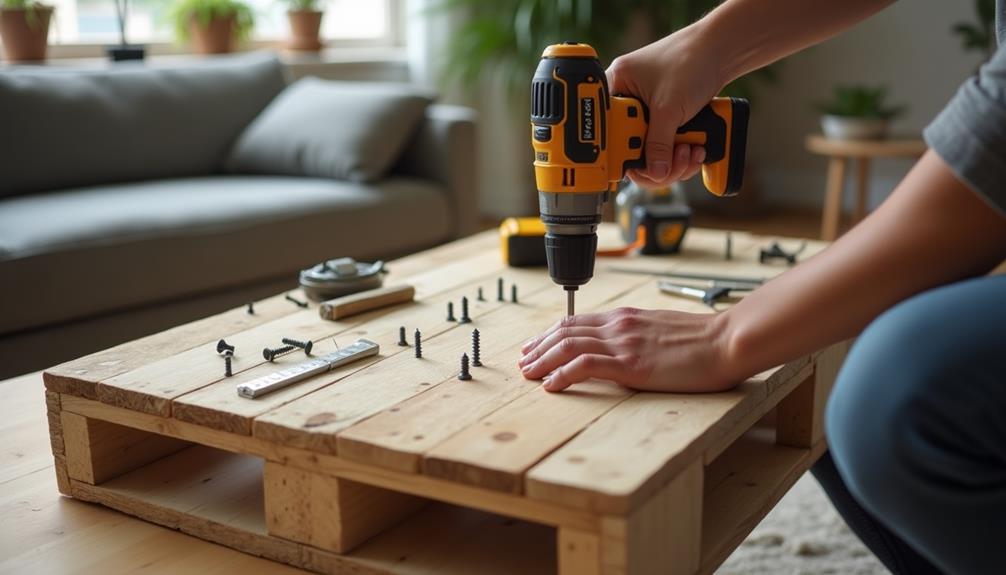
As you dive into assembling your pallet coffee table, gather all the necessary materials and tools beforehand to streamline the process. You'll need your pallets, screws, wood glue, a drill, and a saw.
Start by laying out your pallets according to your design considerations. Decide on the height and shape of your table, as these factors will influence how you assemble the pieces.
Begin with the base. Use two pallets side by side for stability, securing them together with screws. Make sure to pre-drill to avoid splitting the wood. If you're using additional pallets for the tabletop, stack and secure them firmly on top.
When attaching the legs, consider using sturdy corner brackets for added support. This assembly technique will enhance the durability of your table, ensuring it withstands everyday use.
Also, don't forget to check for levelness after each step; an even surface is crucial for functionality.
Once you're satisfied with the assembly, double-check all screws and joints for tightness. With everything in place, you're one step closer to enjoying your unique, handcrafted coffee table!
Sanding and Finishing Touches
Once your pallet coffee table is assembled, it's time to focus on sanding and finishing touches.
You'll want to choose the right sandpaper grit to smooth the surface, then apply a wood stain to enhance its beauty.
Choosing Sandpaper Grit
When it comes to choosing sandpaper grit for your pallet coffee table, you'll want to dial in the right level of smoothness for your finish.
Start with a coarse grit, like 60 or 80, to remove any rough spots or splinters from the pallets. This initial sanding is crucial for a solid foundation.
Next, you'll want to follow a grit progression. Move to a medium grit, such as 120 or 150, to smooth out the surface further. This step helps eliminate scratches left by the coarser sandpaper and prepares the wood for finer sanding.
Applying Wood Stain
Applying wood stain to your pallet coffee table can dramatically enhance its appearance and protect the wood. Before you begin the stain application, make sure you've sanded the surface thoroughly to create a smooth base. This step is crucial for an even finish.
When it comes to color selection, think about the look you want to achieve. Lighter stains can highlight the natural grain of the wood, while darker stains provide a more polished, sophisticated appearance. Test a small area first to see how the stain interacts with your wood.
Once you've chosen your color, apply the stain using a brush or a clean rag, working in the direction of the wood grain. Make sure to cover all surfaces evenly. Allow the stain to penetrate for the time recommended on the label, usually around 5 to 15 minutes, then wipe off any excess.
After the stain has dried, inspect your table for consistency. If you desire a deeper hue, you can apply a second coat following the same procedure. This process not only beautifies your coffee table but also helps preserve it for years to come.
Protective Finish Options
To fully protect your pallet coffee table, you should regularly consider applying a protective finish after staining. This step is crucial for enhancing the wood's longevity and appearance.
Among the finish options, eco-friendly finishes, like water-based polyurethane or natural oils, stand out. They're not only safe for your family and pets but also provide a durable layer against scratches and moisture.
When choosing a finish, think about durability considerations. For a table that'll endure daily use, a high-quality polyurethane offers excellent protection. If you prefer a more natural look, consider using a tung oil or a beeswax finish, which penetrates the wood and creates a water-resistant barrier.
Before applying any finish, ensure you've sanded the surface smoothly to promote better adhesion. Start with a medium-grit sandpaper and follow up with a fine grit for a polished surface.
Once you've sanded, wipe the table clean to remove dust before applying your chosen finish.
Adding Functional Features
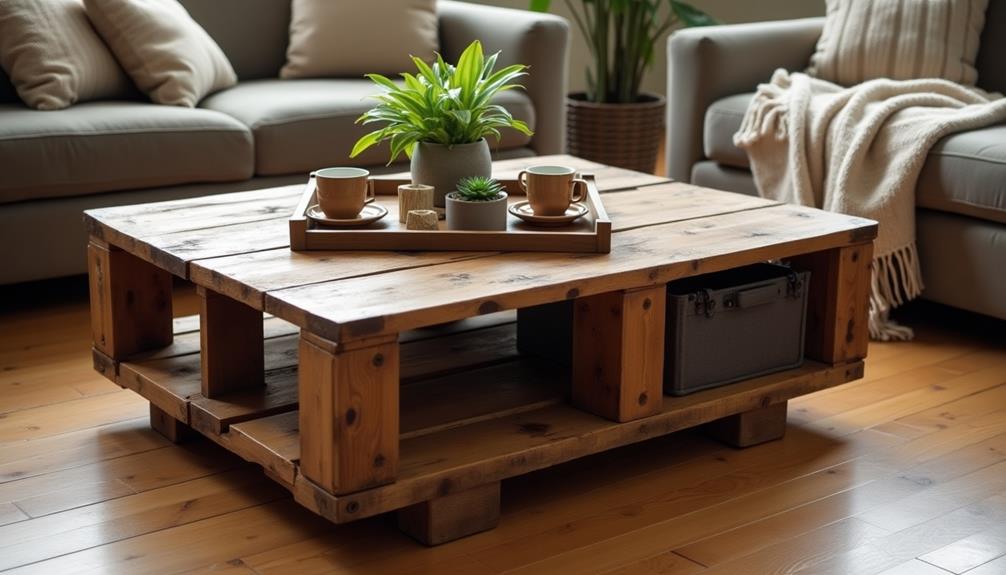
Transforming your pallet coffee table into a multifunctional piece can elevate both its practicality and aesthetic appeal. One of the best ways to achieve this is by incorporating clever storage solutions that keep your space organized. You can easily add hidden compartments beneath the tabletop, allowing you to store coasters, magazines, or even blankets without cluttering your living area.
To create these hidden compartments, consider using sliding panels or lift-off tops. This way, you maintain the rustic charm of the pallet while providing a discreet space for your essentials.
If you want to take it a step further, think about adding wheels to your coffee table. This feature not only enhances mobility but can also facilitate access to those hidden compartments.
Another option is to integrate a shelf or two within the frame of the table. This could serve as a display area for books or decorative items while still providing additional storage.
Styling Your Coffee Table
When it comes to styling your coffee table, balancing functionality and aesthetics is key. Start by selecting a color palette that complements your living space. Think about color combinations that work harmoniously together—neutral tones can create a calm vibe, while bold colors can add a pop of personality.
Next, incorporate decorative accents that reflect your style. A stack of books, a stylish vase, or a small sculpture can serve as eye-catching focal points.
Don't forget about layering! Use trays to corral smaller items like coasters or candles, keeping the table organized and visually appealing.
Consider the height of your decorative elements as well. Mix various heights to create an interesting visual dynamic. For example, pair a tall candle holder with a low bowl filled with seasonal items like pinecones or shells.
Lastly, leave some space for practicality. Ensure you've got room for snacks, drinks, or whatever else you might need.

